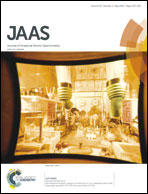Atomic spectrometry updates: Review of advances in atomic spectrometry and related techniques
Abstract
This review covers developments in ‘Atomic Spectrometry’. It covers atomic emission, absorption, fluorescence and mass spectrometry, but excludes material on speciation and coupled techniques which is included in a separate review. It should be read in conjunction with the other related reviews in the series.1–6 A critical approach to the selection of material has been adopted, with only novel developments in instrumentation, techniques and methodology being included. A number of themes have emerged from this year's review. Novel developments in sample preparation include the use of magnetic nanoparticles for solid phase extraction and an increase in the number of viable methods for use in quantitation of peptides, proteins and DNA by elemental tagging, particularly the development of multiplexed techniques. There were also some advances in electrochemical vapour generation, such as the use of reducing reagents immobilized on electrodes and development of electrolytic membrane diffusion cells. New instrumentation has been to the fore, with research into some novel and interesting miniaturized plasma sources being of particular interest, plus the development of a new distance of flight (DOF) mass spectrometer. There have been some insightful fundamental studies of particle atomization and ionization in ICP-MS, and subsequent space-charge effects after ion sampling, which should enable practical steps to solving some of these problems. One of the main drivers of research in isotope ratio analysis has been to increase detection power to enable smaller and smaller quantities of analyte to be measured, which yields advantages in geochronology and nuclear forensics. Laser ablation has played a large part in many types of analysis where high resolution is required, including analysis of single particles, small inclusions or elemental mapping of tissues, so the development of LA methods with extremely small spot sizes and efficient sample transport to the source has been key. In addition, several novel methods have been developed, such as laser ablation molecular isotopic spectrometry (LAMIS) for isotope ratio analysis, and stand-off LIBS techniques such as ‘underwater LIBS’. In contrast, very little research into the use of chemometrics has been reported, and fundamental studies are generally confined to characterization of new plasma sources.

- This article is part of the themed collection: Atomic Spectrometry Updates

 Please wait while we load your content...
Please wait while we load your content...